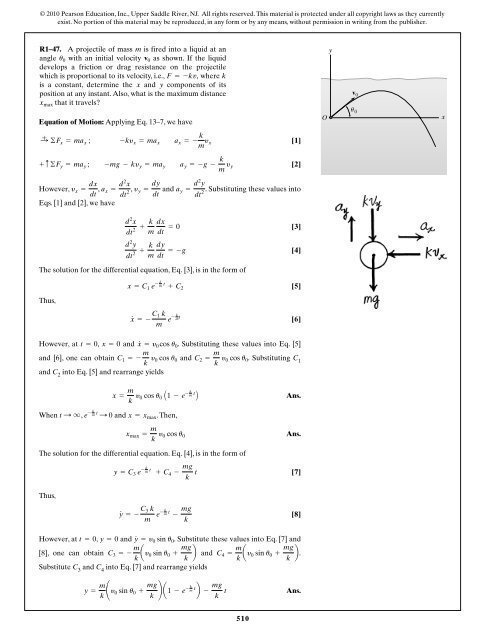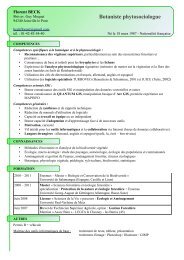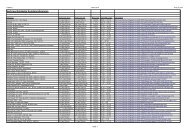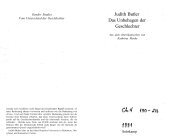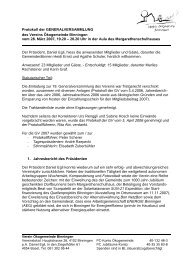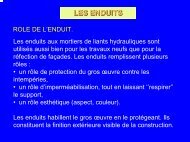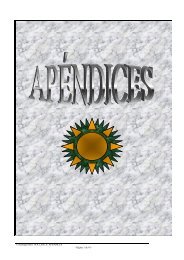479 Horizontal Motion: The horizontal component of velocity ... - Wuala
479 Horizontal Motion: The horizontal component of velocity ... - Wuala
479 Horizontal Motion: The horizontal component of velocity ... - Wuala
Create successful ePaper yourself
Turn your PDF publications into a flip-book with our unique Google optimized e-Paper software.
91962_05_R1_p0<strong>479</strong>-0512 6/5/09 3:56 PM Page 510<br />
© 2010 Pearson Education, Inc., Upper Saddle River, NJ. All rights reserved. This material is protected under all copyright laws as they currently<br />
exist. No portion <strong>of</strong> this material may be reproduced, in any form or by any means, without permission in writing from the publisher.<br />
R1–47. A projectile <strong>of</strong> mass m is fired into a liquid at an<br />
y<br />
angle u 0 with an initial <strong>velocity</strong> v 0 as shown. If the liquid<br />
develops a friction or drag resistance on the projectile<br />
which is proportional to its <strong>velocity</strong>, i.e., F = -kv, where k<br />
is a constant, determine the x and y <strong>component</strong>s <strong>of</strong> its<br />
position at any instant. Also, what is the maximum distance<br />
x max that it travels?<br />
Equation <strong>of</strong> <strong>Motion</strong>: Applying Eq. 13–7, we have<br />
O<br />
v 0<br />
0 u<br />
x<br />
: + ©F x = ma x ; -ky x = ma x a x = - k m y x<br />
[1]<br />
+ c ©F y = ma y ; -mg - ky y = ma y a y = -g - k m y y<br />
[2]<br />
However, , , and a y = d2 y<br />
a y y = dy<br />
x = d2 x<br />
y x = dx<br />
. Substituting these values into<br />
dt dt 2 dt dt 2<br />
Eqs. [1] and [2], we have<br />
d 2 x<br />
[3]<br />
dt 2 + k dx<br />
m dt = 0<br />
d 2 y<br />
[4]<br />
dt 2 + k dy<br />
m dt = -g<br />
<strong>The</strong> solution for the differential equation, Eq. [3], is in the form <strong>of</strong><br />
Thus,<br />
x = C 1 e - k m t + C 2<br />
x # C 1 k<br />
= -<br />
k m<br />
e- m t<br />
[5]<br />
[6]<br />
However, at t = 0, x = 0 and x # = y 0 cos u 0 . Substituting these values into Eq. [5]<br />
m<br />
and [6], one can obtain C and C 2 = m 1 = -<br />
. Substituting C<br />
k y 0 cos u<br />
k y 0 cos u 0<br />
0<br />
1<br />
and C 2<br />
into Eq. [5] and rearrange yields<br />
x = m k y 0 cos u 0 A1 - e - k m t B<br />
Ans.<br />
When t : q, e - k m t : 0 and x = x max . <strong>The</strong>n,<br />
x max = m k y 0 cos u 0<br />
<strong>The</strong> solution for the differential equation. Eq. [4], is in the form <strong>of</strong><br />
y = C 3 e - k m t<br />
+ C 4 - mg<br />
k t<br />
Ans.<br />
[7]<br />
Thus,<br />
y # C 3 k<br />
= -<br />
k m<br />
e- m t - mg<br />
k<br />
[8]<br />
However, at t = 0, y = 0 and y # = y 0 sin u 0 . Substitute these values into Eq. [7] and<br />
[8], one can obtain C m<br />
and C 4 = m .<br />
k ay 0 sin u 0 + mg<br />
3 = -<br />
k ay 0 sin u 0 + mg<br />
k b<br />
k b<br />
Substitute C 3<br />
and C 4<br />
into Eq. [7] and rearrange yields<br />
y = m k ¢y 0 sin u 0 + mg<br />
k ≤ a1 - e- k m t b - mg<br />
k t<br />
Ans.<br />
510


